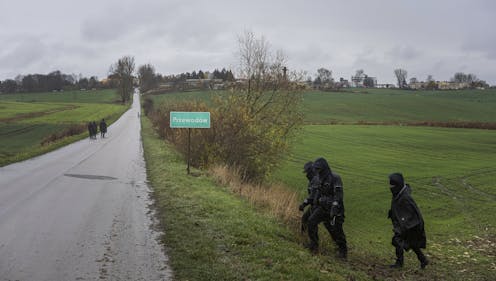
Since the beginning of November, Russia has engaged in its largest ever missile strike against Ukraine’s infrastructure. On Nov. 15, 2022, two civilians were killed by a stray missile in Przewodów, on Poland’s southeastern border.
Immediately, condemnations against Russia by western observers poured over social media as Ukrainian President Volodymyr Zelenskyy accused the Russians of being responsible.
But facts quickly emerged to disprove this. Poland invoked Article 4 of NATO’s North Atlantic Treaty that allows it to call for an extraordinary consultation of the alliance’s member states to discuss the issue.
U.S. President Joe Biden, Poland’s Andrzej Duda and NATO Secretary General Jens Stoltenberg announced that the deadly explosion was likely caused by a Ukrainian S-300 missile.

The aged S-300 systems were working overtime to protect Ukraine from a barrage of incoming air assaults, which led to the incident. It was a tragic but accidental case of friendly fire.
This series of events serves as a timely reminder of the perpetual risks of escalation that come from a conventional war being fought on NATO’s doorstep by one of its implicit allies.
It also offers three lessons to diminish the panic that any future incident is bound to create.
The probabilities of wartime mishaps
As Bruno Tertrais, deputy director of the Foundation for Strategic Research, has argued, wartime “friction” has a tendency to accumulate.
The longer a conflict lasts, the more risk there is of mishaps. Wartime friction is a combination of luck, imperfect knowledge, means that are mismatched to accomplish their aims and uncertainty. It pervades every aspect of war.
As a war increases in intensity, there’s a bigger chance of accidents happening. In the Ukrainian context, the lesson here is clear: waiting for the facts before judging and condemning is crucial.
For the past month, Russia has been steadily increasing its bombardments of Ukrainian cities and infrastructure. According to Mariupol’s mayor, Russian missile strikes on his city have killed up to 10,000 civilians.
The scale of these strikes means that the closer they get to NATO’s border, the more likely they are of leading to spillovers. This danger has been the cause of considerable anxiety about escalation in Washington, D.C., and other western capitals for months. But what if the next time an accident happens, the missile truly was purposefully launched from Russia?

How Article 5 works
In the direct aftermath of the Polish missile incident, there was debate about whether Poland would invoke NATO’s Article 5, which is the organization’s guiding principle of collective defence.
While Poland ended up only invoking Article 4, which enabled the consultation of NATO members, it’s worth a reminder that much of the anxiety over Article 5 originated from misconceptions over how it works. The article states:
“The Parties agree that an armed attack against one or more of them in Europe or North America shall be considered an attack against them all and consequently they agree that, if such an armed attack occurs, each of them … will assist the Party … so attacked by taking forthwith, individually and in concert with the other Parties, such action as it deems necessary, including the use of armed force.”
Two points should be understood.
First, that it is unclear whether an accidental missile strike by Russia on Polish territory would actually meet the threshold of an armed attack.
Had Russia been responsible for the Polish missile incident but wasn’t intentionally targeting Poland, its relatively low intensity and magnitude mean it would have probably been more aptly categorized as a “frontier incident” in legal parlance — in other words, a mishap.
That means it might not have qualified as an armed attack and would not justify self-defence.
Second, Article 5 doesn’t actually mandate an armed response. It mandates assistance as deemed “necessary” — nothing more.
For war to be judged the appropriate response, NATO would need to reach a unanimous consensus of its 30 members on two fronts. First, whether the incident reaches the threshold of an armed attack. Second, whether an armed response is appropriate.
Those are two high bars to meet. They are even higher to meet when there is widespread escalation anxiety within NATO over the Ukraine war.

Diminishing the risks
Similar incidents amid the war, whether they’re caused by Russia or Ukraine, should be anticipated — and prepared for. The recent cautious approach emphasizing fact-finding — adopted by the Biden administration, NATO and Poland — should be emulated.
Jumping to conclusions is dangerous, and maintaining uncertainty to score some momentary points over Russia would likewise be irresponsible.
When the potential result of uncertainty is war between nuclear powers, waiting for the evidence and assessing it as it emerges is the best way to ease tensions.
That doesn’t mean excusing Russia’s relentless shelling of Ukraine’s civilian population, or doing nothing to diminish risks.
NATO allies should emulate the steps taken by countries like Germany to help strengthen the eastern NATO members’ capacity to secure their airspace. The Germans provided Poland with Patriot defence systems capable of intercepting incoming missiles.
NATO should also consider doing the same for Ukraine since more of these incidents are likely as the war drags on.
Émile Lambert-Deslandes receives research funding from the Ontario provincial government, Queen's University, and from the Network for Strategic Analysis, an independent initiative funded by the Canadian Department of Nation Defence and hosted at the Queen's University's Centre for International and Defence Policy.
This article was originally published on The Conversation. Read the original article.







